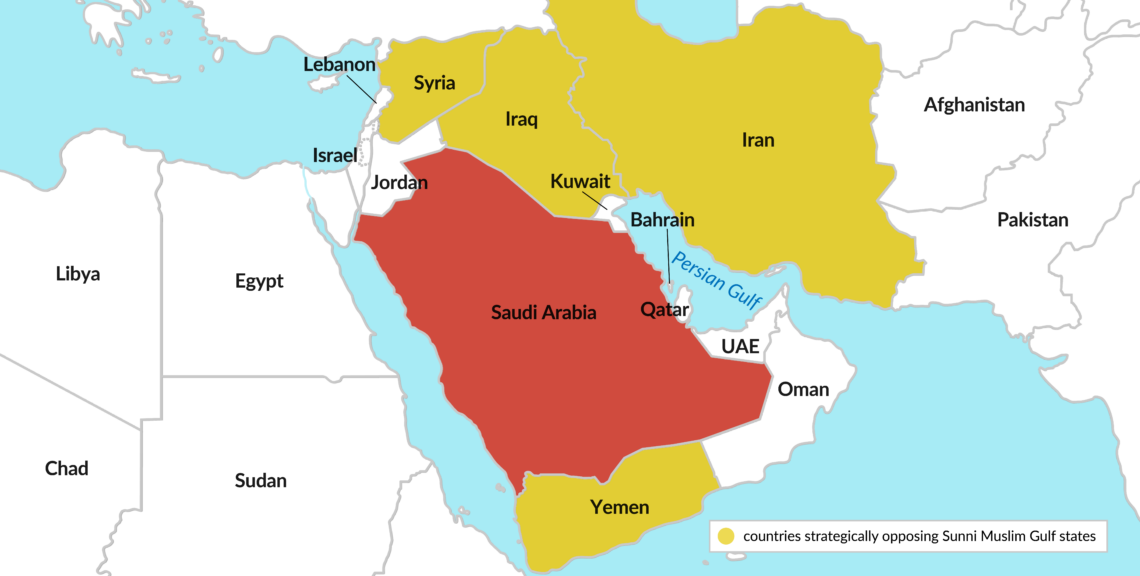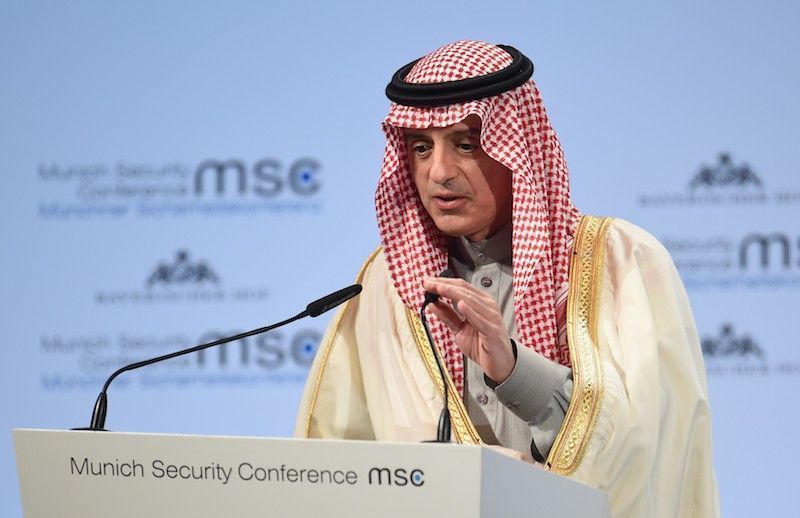Geopolitics and Saudi Arabia’s cash flow
The Gulf states have not sufficiently adjusted their spending patterns to lower income from oil exports. Burdened by persistent and growing budget deficits, they are increasingly hard pressed to fend off geopolitical rivals such as Iran. The trend has serious and lasting consequences for the Middle East and North Africa.

In a nutshell
- Saudi Arabia finds itself strategically and geographically encircled by Iranian influence
- The Gulf states have accumulated crushing budgetary deficits due to low crude oil prices and continued high spending
- No longer able to use their checkbooks to buy international influence and security, the Gulf kingdoms face an uncertain future
Oil-producing Gulf states have accumulated large and persistent budget deficits over the past several years. This economic trend is having a growing geopolitical impact on the Middle East and North Africa, making the region more volatile.
The deficits have been caused by a global decline in crude oil prices that has kept them consistently below the levels needed by the Gulf states for their budgets to break even. Over time, the red ink added up and severely constrained these states’ ability to pay for external geopolitical benefits and influence. Their clout in places like Lebanon, Yemen and, to a degree, Syria has already diminished.
The International Monetary Fund calculates that Saudi Arabia needs oil prices to average $70 per barrel in 2018 for its budget to break even. In 2017, the break-even price was $73 per barrel and in 2016 it was $96. This compares to the United Arab Emirates’ (UAE) estimated break-even point of between $75 and $80 per barrel in 2018. These figures are high when compared to Kuwait’s $46.50 and Qatar’s $46.80.
The average crude oil price is projected to remain between $50 and $60 per barrel in the medium term, having been as low as $40 and sometimes below that in the not-so-distant past. The resulting price gap could swell the sum of already accumulated and probable future fiscal deficits to $600-$700 billion for the oil-exporting Gulf states.
The main geopolitical challenge for the Gulf states is their inability to counter Iran’s growing influence in the region.
Simultaneously, the deficits have also led to depletion of the Gulf states’ cash reserves, in some cases forcing them to liquidate some of their international investments. Outside the Middle East, investments made by sovereign wealth funds enabled the Gulf states to expand their political footprint – particularly in Europe – disproportionately to their size.
Less money, less security
The ability to exert petrodollar-based influence across the Middle East, North Africa and even Europe was vital for these states, particularly for Saudi Arabia. Rich as they were, they failed to create new methods, other than money, to pursue their national interests effectively. By contrast, Iran, their main regional protagonist, has developed such tools despite having been under economic sanctions for the past four decades. Today, these instruments include propaganda and the paramilitary and political muscle of nationality-based groups operating outside Iran’s borders, e.g. Hezbollah which functions as the dominant political force in Lebanon and a military force in southern Lebanon and parts of Syria.
The main geopolitical and strategic challenge for the Gulf states, particularly for Saudi Arabia, can now be defined as their inability to counter Iran’s growing influence in the region or check its encroachment into spheres of influence where the Saudi diplomacy traditionally held considerable sway. This challenge is grave. Saudi Arabia finds itself strategically and geographically encircled by Iranian influence to the south (Yemen), north (Iraq and Syria) and east across the waters of the Gulf (Iran). Moreover, the blockade of Qatar, which shares a common border with the Saudi state, has pushed that country closer to Iran, with which it shares one of the largest offshore gas fields.
Exacerbating this downward spiral of influence is continued growth in the Gulf states’ base costs – both in domestic expenditure on the social programs necessary to secure social and civic peace, and (particularly in the Saudi case) on external wars in Yemen and Syria.
Aggregate budget deficits in these countries rose nearly tenfold to 10.6 percent of gross domestic product (GDP) in 2016, from a mere 1.1 percent in 2014. While higher oil prices and cuts in public expenditure are expected to cut the deficit ratio in half in 2018, the revenue-spending gap will persist. The accumulated losses and contingent costs will continue to produce deficits of varying sizes for the region’s states.
Melting reserves
In 2017, Saudi Arabia’s financial reserves were significantly reduced from more than $700 billion to less than $500 billion, as the country attempted to cover the state budget deficit and its mounting expenses. The reserves are likely to get depleted further, though much depends on what happens in Yemen. The war there is believed to be costing the Saudis at least $12 billion per year (although some estimates put the figure at three times as much, or $200 million per day) and has already been going on for three years.
Moreover, when King Salman bin Abdulaziz ascended to the throne in 2015, he ordered pay increases and bonuses for public sector employees, who account for 70 percent of the country’s working population. The bill for this largesse is estimated to be $120 billion. Add to this stunted growth of non-oil sectors of Saudi Arabia’s economy, the aggregate of which remain below historical averages.
The IMF calculates that the Gulf states’ non-oil growth is likely to be around 3.4 percent by 2020, barely half the 6.7 percent average for 2000-2015. The impact of this slowdown will be amplified by growing arrears in public-sector payments to private contractors, which in turn will lead to liquidity problems in the private sector and, by extension, to potential trouble in the banking system. Such payment delays may bring the likes of Saudi Binladin Group and Saudi Oger LTD., once two of the largest contractors in the Middle East, to the brink of bankruptcy.
Saudi Arabia, the UAE and Kuwait stepped in to shore up Egypt’s public finances with a combined $17 billion injection.
Moreover, some private sector employees are not always getting paid on time. Should this trend spread, the consumption component of the economy will also come under considerable strain. The Saudi government announced – and quickly reversed – austerity measures aimed at narrowing the deficit, including cuts in subsidies to public utilities. The reversal was politically necessary because Saudi Arabia is a rentier economy whose population depends on and expects beneficence from the state. However, as further evidence of the very considerable budgetary strain, both Saudi Arabia and the UAE introduced a 5 percent value-added tax (VAT) recommended by the IMF on January 1, 2018.

The case of Egypt
The negative geopolitical impact of fiscal overstretch has been considerable and, to a large extent, irreversible. When Abdel-Fattah El-Sisi overthrew the Muslim Brotherhood regime and took over Egypt’s presidency from the democratically elected Mohamed Mursi (2012-2013), Saudi Arabia, the UAE and Kuwait stepped in to shore up Egypt’s public finances with a combined $17 billion injection. This helped make up for the $2 billion in annual aid canceled by the United States and secured President Sisi’s rule against a resurgence of the Muslim Brotherhood that was supported by Turkey and Qatar.
Gaining a foothold in Egypt against all regional and global powers by simply wielding a checkbook appeared to be a geopolitical triumph for the Gulf states. Today, however, they would struggle to replicate this feat, should another opportunity present itself. Even retaining their gains in Egypt has proved difficult as Cairo drifts away from Riyadh and the UAE in its foreign policy. Egypt did join the blockade of Qatar but wants no part in the war in Yemen and has refused to support the Saudi-UAE drive for influence in the Horn of Africa.
Moreover, Egypt has been working quietly against removing President Bashar al-Assad – Riyadh’s avowed objective in Syria – under the banner of maintaining the integrity of Syrian state institutions. In Lebanon, Saudi Arabia has been losing influence to Hezbollah and Iran, as its Sunni allies can no longer count on effective Saudi backing. The limits to Saudi power have become obvious for all to see during the drama surrounding Lebanon’s Prime Minister Saad Hariri, who in November 2017 visited Riyadh, only to be held hostage in the Iran-Saudi Arabia proxy conflict in Lebanon. Mr. Hariri managed to return home and retain his post only after French President Emmanuel Macron intervened.
Scenarios
It may have mattered that Mr. Hariri, who is also a Saudi citizen, had inherited his family’s interest in Saudi Oger LTD. – the construction, engineering and real estate conglomerate founded by his late father, a former prime minister of Lebanon. The Saudi public bodies owe the company a great deal of money for commissioned projects, presumably so because of public finance difficulties. The dispute over unpaid invoices was a factor in the saga of Mr. Hariri’s ill-fated trip to Riyadh. This is an interesting example of how the growing fiscal crunch can lead to controversial political moves, which soon acquires a geopolitical dimension – in this case weakening Saudi interests.
More consequences may soon be in store. The war in Yemen, for example, may well reach a point where it becomes financially unsustainable for the Saudis, who will be forced to seek a settlement and withdraw. In fact, Iran may well have supported the Houthis’ low-intensity insurgency in Yemen mainly to drain the Saudis financially. This could have knock-on effects on Saudi influence elsewhere in the region, notably in Syria and Lebanon. It would also blunt any commercial advantages that Riyadh might offer Baghdad as part of the ongoing Saudi-Iraqi rapprochement, which threatens to undermine Iran’s supremacy over Iraq by ending 30 years of conflict.
The central scenario is for the cash flow-driven geopolitical weakening to continue for the Gulf states, especially Saudi Arabia. The result will be a further strengthening of Iran’s regional position in Syria, Lebanon and possibly Iraq. This is a dangerous development, as it would force the U.S. and Israel to conclude that the Iranian threat to their strategic interests across the region is clear and imminent.
The leadership in Tehran, meanwhile, will be emboldened to act even more aggressively, possibly cross the red lines. Iranian President Hassan Rouhani recently boasted that his country controlled four key Arab capitals: Damascus, Baghdad, Sana’a and Beirut. Iran is building military bases in Syria and increasing its presence near Israel’s highly sensitive border in the Golan Heights. U.S. Secretary of State Rex Tillerson’s recent declaration that the U.S. is in Syria for the long haul, in part to counter Iran’s influence, could be the starting gun for a larger confrontation.






